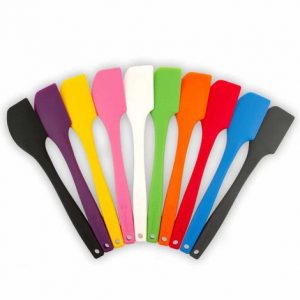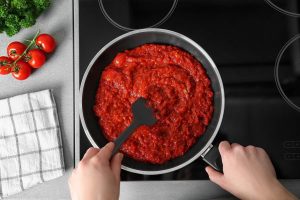The Use of Silicone Cooking Utensils and Tools
Silicone utensils and tools are a great choice because they are durable, versatile, and never damage pots and pans. There is a wide range of silicone utensils available, so find the one best suited for your needs.

What are silicone utensils?
Silicone utensils are nonstick cookware that is made from silicone. They have a smooth surface and heat up quickly.
Is silicone good for cooking utensils?
On the plus side, silicone is a very durable material that can withstand high temperatures. It also has a nonstick coating, so it can be a great option for cooking utensils that need to be able to slide easily across surfaces. Additionally, silicone is relatively inexpensive compared to other materials like metal or wood.
However, there are some drawbacks to using silicone for cooking utensils. One is that it’s not as heat-conductive as other materials, so it might not be the best choice if you’re looking for something that will help you cook food evenly. Additionally, because it’s non-stick, it can be difficult to clean if food gets burnt or stuck to the surface.
What are the pros and cons of silicone bakeware?
Some people love it. Others swear by their metal mixer, cooking spoon, or another non-silicone kitchen utensil.
Here’s a quick rundown of what these materials can do for your cooking endeavors.
The pros of silicone bakeware are that it is less expensive than other forms of bakeware, including ceramic and Pyrex. The cons include the inability to prepare various baked goods, like other types of bakeware.
Pros of silicone bakeware
Silicone bakeware has many advantages over its non-silicone counterparts. These include no need for oil or butter because it doesn’t get stained by foods like greasy cast iron cookware, easy cleanup due to lack of crevices on which food can stick, and the ability to be used in the oven or microwave.
- The silicone is FDA-approved and food-grade, making it safe for your health.
- It can withstand high temperatures, making it ideal for baking.
- No fragile glass pieces to break.
- Easy cleanup with soap and water or wipe over with a paper towel.
- Doesn’t scratch like some metals might when moving pans around.
- Easy to transport as it can go in the oven without fear of melting.
- Bakes evenly, leaving a consistent pattern throughout your cakes and cookies.
Cons of silicone bakeware
Here is a list of some cons to help you decide which bakeware type to use.
- Can’t use silicone bakeware with an induction stovetop.
- Not all silicone bakeware is made of food-grade materials.
What makes silicone kitchen tools different?
Silicone kitchen tools and cooking utensil have characteristics that offer some advantages over their stainless steel, plastic, rubber, or wooden counterparts. Most silicone products come in bright colors. Aside from that, let’s consider their other characteristics and see if silicone kitchen utensil is worth using.

Silicone utensils have high-heat resistance
It can withstand high heat (some manufacturers claim heat resistance of up to 600 degrees Fahrenheit). If you’re using silicone turners or whisks in cooking, you don’t have to worry that they will melt when you accidentally leave them in the pot for a while. I remember using non-stick turners, which melt when you dip them in hot oil. There are even silicone pot holders and gloves which are perfect for taking out the dish from a very hot oven.
Silicone kitchenware are stain-resistant
This is because of the non-porous characteristic of silicone. So that it doesn’t retain odors or colors when you use it to stir deep-colored food like tomato-based food. Have you experienced how difficult it is to remove spaghetti sauce stains on your rubber spatula? This also lends silicone products to easier cleaning or washing. Compared to a wooden spoon, which is porous and can harbor microbial growth, the silicone utensil set is usually non-toxic, BPA-free, and food-grade.
Silicone cooking utensils are rubber-like
This makes them very user-friendly when dealing with non-stick surfaces. It cannot scratch or damage non-stick cooking pots and pans like wooden or stainless steel spoons. This flexibility makes it as useful as the rubber spatula set to clean the cake batter off the mixing bowl.
Silicone cooking utensils are non-corrosive and hard-wearing
Food-grade silicone is very safe to use in any food. It does not react with food or beverages or produce any hazardous fumes. Unlike some metals, which may corrode when exposed to certain acids in food. It does not react negatively to exposure to extremes of temperature. This means that it will probably last longer than another kitchen utensil.
Silicone cooking utensils are safe to use
In the “The Safe Use of Cookware” article by Health Canada, it is mentioned, and I quote, “There are no known health hazards associated with the use of silicone cookware.”
Additional notes before buying silicone kitchen tools
When buying stuff, it is a good idea to consider some points to ensure that you’re buying quality products. Here are some comments or complaints of other customers buying a silicone kitchen tool. It would be wise to take note of them.
Consider the purpose of buying silicone kitchen tools. Some people complain that silicone spatulas work great for smoothing out the cookie dough or batter from the bowl but are not rigid enough for other cooking purposes. Remember that these are rubber-like, so they may not be good to use when sauteing especially when you need to cut through meat while cooking.
Check the handle. Silicone handles will tend to be floppy or soft, so they may not provide the leverage you need while cooking, especially when they are subjected to high temperatures. You may consider silicone kitchen tools with long, sturdy handles, perhaps those made with metal or hard plastic (this may be prone to melting, though). It is best to find out also from previous customer reviews online if the handles don’t break to be sure that you’re buying good quality utensils.

FAQs
You may wonder what silicone is and why it’s important for your kitchenware. Here are some frequently asked questions to help clear things up.
Is silicone rubber or plastic?
Silicone is an artificial polymer that is found in many household items. It is heat-resistant and has a variety of uses, including cookware, bakeware, and electrical insulation. Rubber and plastic are both made from petroleum products. Rubber is vulcanized, meaning it has been treated with chemicals to make it stronger and more durable. Plastic is a synthetic material that can be molded into various shapes.
Can silicone utensils go in the dishwasher?
Silicone cooking utensils are a popular choice for men. They are non-stick, heat-resistant, and easy to clean. However, there is some debate about whether or not silicone utensils are safe to put in the dishwasher.
The main concern with putting silicone utensils in the dishwasher is that the high temperatures can damage the material. This can cause the utensils to warp or melt. Additionally, detergents and other chemicals used in dishwashers can also degrade silicone. For these reasons, it is generally recommended that you handwash your silicone cooking utensils.
If you decide to put your silicone utensils in the dishwasher, use a gentle cycle and avoid using harsh detergents. After washing them, you should also inspect your utensils to ensure they have not been damaged.
How do you clean silicone utensils?
If you’re like me, you probably have a few silicone cooking utensils in your kitchen. They’re great for non-stick cooking and easy to clean, but there are a few things you should know about cleaning them.
First of all, silicone utensils are dishwasher safe, but handwashing is preferable. This is because the dishwasher can sometimes leave water spots on the utensils. If you wash them in the dishwasher, put them on the top rack, so they don’t get damaged by the water spray.
Secondly, don’t put silicone utensils in the microwave or oven. The high heat can damage the silicone and make it less effective as a cooking tool.
Finally, if your silicone utensils start to look dull or discolored, you can revive them by washing them in warm soapy water and then drying them with a soft cloth.
Conclusion
Should you make the switch?
On the pro side, silicone is a very versatile material that can be used for many different cooking tasks. It is heat-resistant, non-stick, and easy to clean. In addition, silicone utensils and tools are often more affordable than stainless steel or wooden cooking utensils.
On the con side, some people worry that silicone may leach chemicals into food when heated. However, there is no evidence to support this claim. Additionally, silicone can be more difficult to store than other materials since it doesn’t stack well.
- The Benefits of Baking: Experts say baking reduces stress and anxiety - February 27, 2022
- Effective and Reliable Ways to Organize Bathroom Drawers - January 26, 2022
- Looking For a Frying Pan With a Lid: A universal lid for all your pots and pans - August 16, 2021


